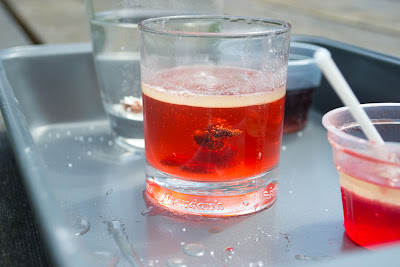Read aloud:
Mr. Wilson's Cabinet of Wonder
This is not a book marketed to children. I started reading it to her on a lark and had my doubts that she would comprehend it and/or that it would hold her interest, but she surprised me and really did enjoy it.
Spine:
Strange Mysteries from Around the World, Seymour Simon.
This book is written at her reading level (approximately 4th grade) so we could easily read it together and use it as a base from which to jump off into more detail. This book was originally written in the early 1980s, so it was interesting to compare some of the information in this book with newer information from other sources.
Supplementary books:
- Unexplained! Strange Sightings, Incredible Occurrences, and Puzzling Physical Phenomena, Jerome Clark. A big, dense book of more obscure unexplained phenomena. We read selected portions aloud. Miss L particularly liked the monster sightings.
- Weird Washington and Weird U.S.: A Freaky Field Trip Through the 50 States Both of these include short vignettes of the unusual and unexplained. Nice geography tie-in. Weird U.S. is intended for kids, but Weird Washington is also fine for the interested kid.
- Unexplained, Judy Allen Kids title. In the style of Eyewitness books.
- The Griffin and the Dinosaur
- Ripley's Search for the Shrunken Head and Other Curiosities Interesting pop-ups and interactive materials in this one.
- Other Ripley Believe It or Not books
- Enigmas, Vowery Carlisle. A writing curriculum using historical mysteries
Documentaries (all available on Netflix):
- The Legend of the Crystal Skulls
- Selected episodes of Myth Hunters and/or Weird or What? (preview to see which you prefer)
- Selected episodes of Oddities (currently unavialable)
Projects/Hands On/Field Trips
- Made a mythical creature fossil out of bones from an owl pellet
- Made a fairy mummy and/or Fiji mermaid out of small novelty halloween skeletons and craft supplies
- Found an unknown baby animal on the lawn, tried to identify it. Took it to a local museum to get it positively identified and preserved.
- Visited the website of the Pacific Northwest Tree Octopus. True? Fake? How can you tell?Can you fool others with your own creation?
- Curated her own exhibit of "weird stuff" in a curio cabinet and made a companion guidebook
- Visit museums like Ye Olde Curiosity Shop, Ripley's exhibit at the science center, other small local oddity shop/museums.












